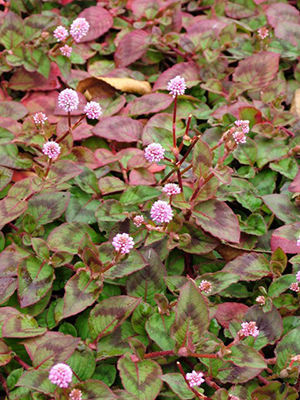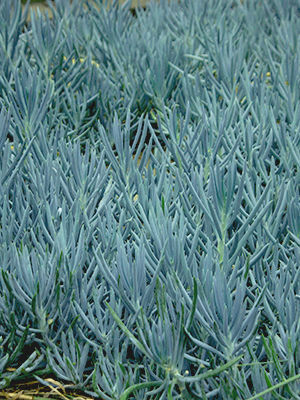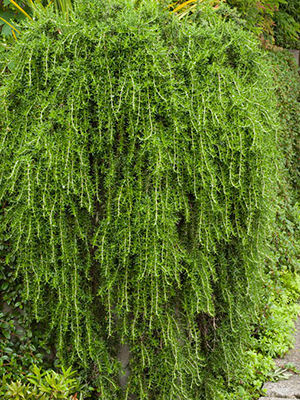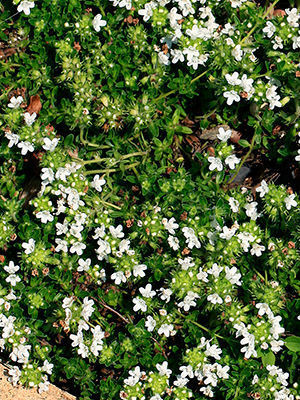1. Pink Knotweed

Name: Persicaria capitata
USDA hardiness zones: 8 to 9
Size: 3 to 6 inches tall and up to 20 inches wide
Conditions: Full sun to partial shade; well-drained soil
This delicate-looking but rugged and vigorous evergreen ground cover is best used in flat areas, not on slopes, because it’s not conducive to erosion control. It creates a dense, ground-hugging mat. Drought tolerant once established, it becomes lush and colorful starting in spring and continues throughout the season. Because it spreads by rooting stems and self-seeding, pink knotweed is perfect for filling in around border perennials and shrubs.
2. Blue Chalk Sticks

Name: Senecio serpens
Zones: 7 to 11
Size: 10 inches tall and up to 3 feet wide
Conditions: Full sun to partial shade; well-drained soil
Blue chalk sticks is a drought-tolerant, ground-hugging evergreen, ideal for the foreground of plantings with taller perennials and shrubs behind it. This showy succulent has crawling, tubular, tendril-like leaves branching at the base and rooting along the stems where they touch the soil; a striking light blue-green color; and an ability to grow where many other ground covers won’t. Blue chalk sticks is remarkably hardy for a succulent, surviving slightly-below-freezing temperatures (not unheard of in Southern California). It is easy to maintain but will not tolerate foot traffic.
3. ‘Huntington Carpet’ Trailing Rosemary

Name: Rosmarinus officinalis ‘Huntington Carpet’
Zones: 6 to 11
Size: 18 inches tall and up to 4 feet wide
Conditions: Full sun; well-drained soil
‘Huntington Carpet’ is a creeping variety of rosemary that grows rapidly and stays dense and full over time. Both the evergreen leaves and the flowers of this rosemary are edible: The dark green leaves are used for seasoning, and the mostly-year-round, beautiful blue blossoms are a great garnish. This low-growing cultivar doesn’t get as woody or require as much pruning as the more common prostrate rosemary (R. officinalis ‘Prostratus’). It is easy to maintain in small areas and on broad banks, and is excellent for attracting birds and butterflies.
4. White Creeping Thyme

Name: Thymus praecox ‘Albiflorus’
Zones: 2 to 11
Size: 3 inches tall and up to 2 feet wide
Conditions: Full sun to partial shade; well-drained soil
White creeping thyme is an aromatic herb great for filling compact spaces like the nooks and crannies between dry-set flagstones and between rock-garden accent boulders. The purple flowers of the standard variety of creeping thyme provide color, but like any white-flowering plant, this variety lights up in dark areas and in moonlight. Like most herbs, the tiny evergreen leaves of this thyme are best sheared back on occasion to prevent legginess and to form a dense mat.
Frank Mitzel is the owner of Aesthetic Landscape Design in San Diego, California.
Photos: #1, Nancy J. Ondra; #2, Michelle Gervais; #3, Doreen Wynja; #4, Bill Johnson

















Comments
Log in or create an account to post a comment.
Sign up Log in